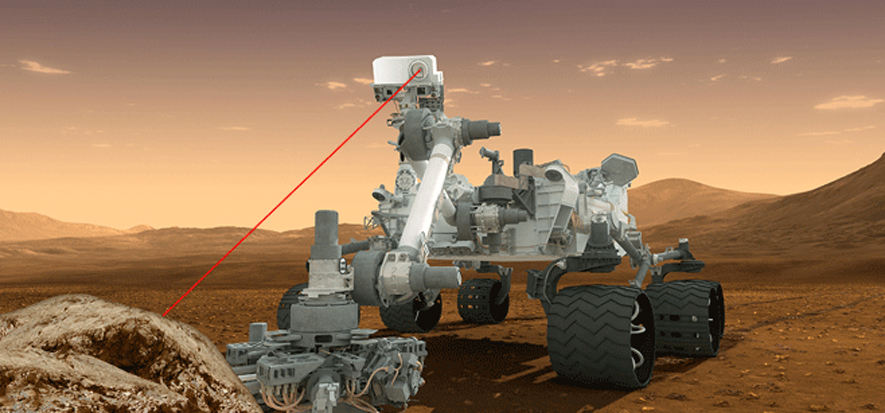Zap! NASA's Curiosity Rover Fires 100,000th Laser Shot on Mars

NASA's trigger-happy Curiosity rover has fired its 100,000th laser shot on Mars, a science milestone in its mission to determine what rocks on the Red Planet are made of, NASA announced Thursday (Dec. 5).
Each laser pulse shot by the Curiosity rover packs the power nearly 1 million light bulbs — strong enough to vaporize rock and dust from up to 30 feet (9 meters) away.
"#PewPewPew I've fired my ChemCam laser 100,000+ times on Mars for SCIENCE!" Curiosity's team wrote in the voice of the rover in a Twitter post Thursday. [Latest Photos of Mars by NASA's Curiosity Rover]
Originating from the French-made ChemCam instrument on Curiosity's "head," these beams are used to study the chemical composition of Mars. ChemCam has a spectrometer that analyzes the light emitted by the zapped targets on Mars. The instrument is sensitive enough to detect light from every element on the periodic table.
The 100,000th laser firing came as Curiosity was shooting a target called "Ithaca" in late October, according to NASA.
Roger Wiens, a planetary scientist at Los Alamos National Laboratory and principal investigator for ChemCam, said the laser-firing instrument has exceeded expectations.
"The information we've gleaned from the instrument will continue to enhance our understanding of the Red Planet, and will nicely complement information from the other nine instruments aboard Curiosity as we continue our odyssey to Mount Sharp," Wiens said in a statement from Los Alamos.
Breaking space news, the latest updates on rocket launches, skywatching events and more!
Rising 3 miles (5 kilometers) from the center of Mars' huge Gale Crater — where Curiosity landed in August 2012 — Mount Sharp is the rover's main destination. Scientists hope Curiosity, which is about the size of a small SUV, will uncover clues about the ancient environment and habitability of Mars while scouring the foothills of the mountain.
The Curiosity rover has already made some amazing discoveries on Mars using ChemCam and its other instruments. Besides findings that Mars had a rather wet past, Curiosity recently helped scientists determine that each cubic foot of surface soil on Mars is made up of 2 percent water, which may be enough to quench the thirst of future astronauts.
"ChemCam was designed to fire one million shots, so we’ll have lots of stories to tell later on," Wiens added.
Follow Megan Gannon on Twitter and Google+. Follow us @SPACEdotcom, Facebook or Google+. Originally published on SPACE.com.

Megan has been writing for Live Science and Space.com since 2012. Her interests range from archaeology to space exploration, and she has a bachelor's degree in English and art history from New York University. Megan spent two years as a reporter on the national desk at NewsCore. She has watched dinosaur auctions, witnessed rocket launches, licked ancient pottery sherds in Cyprus and flown in zero gravity on a Zero Gravity Corp. to follow students sparking weightless fires for science. Follow her on Twitter for her latest project.


